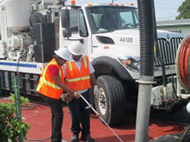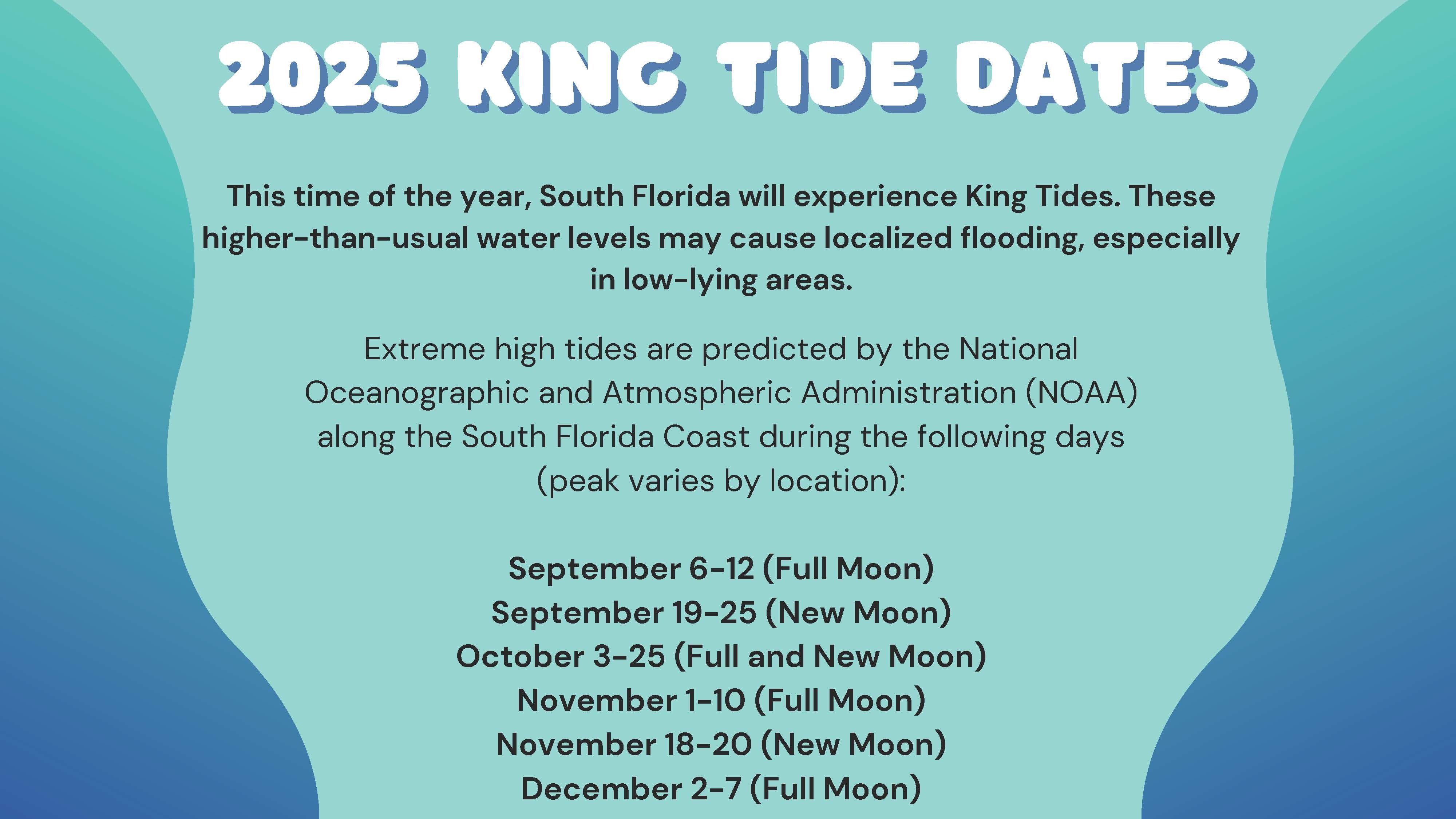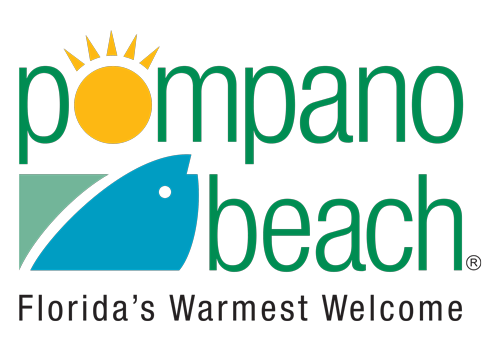Tidal Valves/Stormwater Check Valves
The City of Pompano Beach is working to install Tidal/Stormwater Check Valves (Citywide) to mitigate sea level rise and flooding. These check valves are structures installed on the ends of drainage pipes that allow inland water to discharge out into tidal or downstream waters while preventing water from those areas to flow backwards into the pipe and flood inland areas. The City intends to continue investigating how this strategy for managing tidal inundation can further be utilized in other low-lying areas. The video below highlights how they work.
With a large coastline of waterways and tidal water bodies; a flat topography; and shallow, porous aquifer, Pompano Beach can be subject to sunny day tidal flooding. Flooding in low-lying areas is more likely when the close proximity of the moon, higher than average tides called king tides, rising sea levels, and inclement weather conditions combine to exacerbate flooding risks. Rainfall and wind strength and direction can have a significant impact on the height of the tides causing them to come in higher or lower than predicted. Also note that high water tables (groundwater level) due to rain events can raise the probability of localized flooding.
Storm Water Questionnaire
As part of our stormwater outreach process we are asking customers to aid us by filling out this form. By reporting stormwater related issues, we can better direct our stormwater response and construction program in the future. Thank you for your assistance.
Download Questionnaire - Stormwater Public Outreach on Flooding due to Rainfall




Pompano Canal
In April 2013 the Pompano Canal was delisted. This means that this body of water is now meeting its applicable water body standards and in 2016 will no longer be listed as a verified impaired water body by the Florida Department of Environmental Protection.
Relining Program
Relining of stormwater pipes means covering the inside surface of pipes to increase efficiency and decrease leaks.
Maintenance program
Our ongoing Activities (rain or shine) include: Inspections, system maintenance (such as cleaning drain inlets and underground stormwater pipes) cleaning out drainage structures, sweeping street, stormwater infrastructure construction, relining stormwater pipes.
Construction Discharges (MS4)
To learn more about construction discharges, please see this document.
The Building Division also has more information on Construction Discharges on their flood information page
Getting the Word out… the Role of Local Governments in Implementing the NPDES Stormwater Program for Construction sites.
Success stories
The City completed the Storm water Master Plan update in June 2013. This plan includes 25 storm water projects designed to improve flooding conditions throughout the City. Financing is currently underway to fund these projects at a total cost of 32 million dollars. The work is already under design and will take about 10 years to complete. The projects will be financed for 20 years and through a variety of mechanisms including bonds and state revolving fund loans.
Pollution Prevention and Illegal Discharges

Report illegal dumping in storm drains by calling 954-519-1499
What you can do to protect your property and the environment:
- Maintain any private drainage structures on your property.
- Quickly dispose of trash and other solid waste so that it does not run off onto stormwater grates, especially if heavy rains are in the forecast.
- Maintain your swales (strip of land in front of your home and adjacent to street). Well-maintained swales and lawns increase percolation during a rain event, reducing flooding and improving the quality of stormwater runoff.
- Do not plant trees or shrubs in swale areas. Keep your swale and stormwater grates free of debris such as leaves, limbs, and other vegetation.
- Be stingy with fertilizers, pesticides and herbicides. Using more than you need or applying before a big rain event can cause excessive nutrient and toxic chemical flows into our waterways.
- Do not litter. Litter can wind up in the stormwater grates and pipes. Accumulated litter slows the movement of stormwater, and increases flooding and stormwater maintenance costs. Litter also pollutes receiving waters.
- Appropriately dispose of hazardous materials the can contaminate surface and groundwater (e.g. motor oil, paint, refrigerants, pesticides, industrial chemicals and detergents). These should never be placed into storm grates.
- Minimize vehicle parking time on swales to allow grass to grow and the soil to stay loose and able to percolate.
Storm Water Questions & Answers
What is stormwater?
This is all water coming from precipitation, whether that is from snow, rain, hail, or other.
Why is there flooding after a heavy rain or storm?
After heavy rains it is normal for rainwater to take 24 to 72 hours before it completely percolates into the ground. Drainage systems are designed to handle certain level of storms (such as a 10 year storm lasting 24 hours and delivering 10 inches of rain). When the volume of rain exceeds system designs, or when one rain event quickly follows another rain event, the system cannot meet the drainage requirements and flooding occurs.
Who provides stormwater services?

Depending on your location, your stormwater services may either be provided by the city or by another entity. The state and county are responsible for drainage on their roads. Please click here for a map of stormwater providers.
Do we treat stormwater?
Some stormwater areas have physical systems such as French drains that allow for percolation and solids removal before flowing into retention areas or environmental waterways.
How is stormwater different from wastewater?
The wastewater transmission lines take used potable water from residential and commercial plumbing to the Broward County North Regional Plant for processing. The Storm water system takes runoff from streets and land areas passing through soil or into retention areas before entering environmental waterways.
What is the Stormwater Management Program?
The City of Pompano Beach Stormwater Management Program is designed to provide surface water drainage in an environmentally sound, efficient and effective manner. The City system serves about 25 square miles of land, and 102,000 residents with swales, water retention areas, underground pipes, canals and lakes. Ultimately, the system discharges surface water / rainwater flows to the Intra-Coastal Waterway.
What can I do to help keep the stormwater system working?
Keep the stormwater drains open near your property and make sure you do not plant in the swale area.
What types of services are involved?
Our ongoing activities include: Inspections, system maintenance (such as cleaning drain inlets and underground stormwater pipes) cleaning out drainage structures, sweeping streets, stormwater infrastructure construction, relining stormwater pipes (covering the inside surface of pipes to increase efficiency and decrease leaks.)
Does the City work with other agencies?
Yes. We coordinate private development and the public infrastructure, including other agency facilities, to meet flood protection and water quality goals. These agencies include the South Florida Water Management District, Broward County and even the Florida Department of Transportation.
How do swales help with the management of stormwater?
Swales are created to retain stormwater during and after rain events. If a homeowner fills in the swales or plants in this area, the swale cannot retain as much and flooding can occur.
Why can't I plant trees in the swale?
City Ordinance requires a 5 foot separation between trees and underground utilities. Also: swales are designed to capture and retain water and trees prevent this from being properly maintained as a swale.
What if I see someone dump illegal stuff into the stormwater drain?
You can report illegal dumping in storm drains by calling 954-519-1499
What can I personally do to protect my property and the environment?
Please see our stormwater brochure for more information.
Where can I find more contact information?
Pompano Beach Customer Service: 954-786-4637
Pompano Beach (4:30 pm – 8:00 am, 7 days): 954-942--2202
